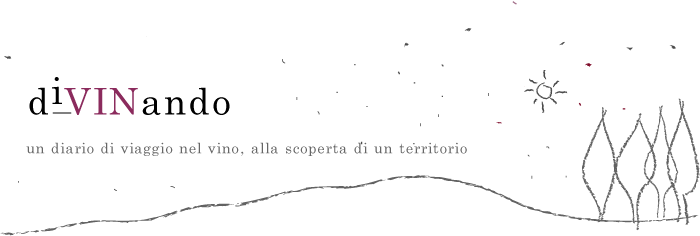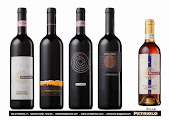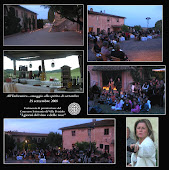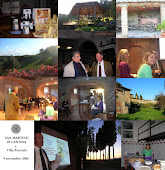mercoledì 12 giugno 2013
Tenuta di Fessina in “The Essence of Etna” by Anthony Giglio. ERSE 2010, a perfect example of the paradox of Etna Rosso wines
Erse is the name of the goddess of the dew; goddess of the call of the sunrise and the dew on the vines and grapes at dawn. Made from 80% Nerello Mascalese and 20% Nerello Cappuccio harvested in October. The wine is fermented in stainless steel for eight to 10 days, macerated for two to three days with two to three pumpovers daily. Erse is a delicate, textured red which reveals gorgeous inner perfume and a silky core of fruit in a medium-bodied style. A very elegant and feminine wine. Pair this wine with sautéed meat and spinach or fish with spicy tomato sauce.
In “The Essence of Etna” Anthony Giglio writes about how wines from the hillside of Sicily’s Mount Etna reflect the unique, volcanic terroir.
SILVIA MAESTRELLI, owner of TENUTA DI FESSINA, spoke with Giglio about her relationship with the volcano: “Visiting Etna helps you understand just how small Man is,” she says. “[Etna is] outlandish in its landscape: in the fire around Randazzo, at the foot of the frightening volcano, and the raining fire and boiling lava; and outlandish in the ability of the people of Etna to live so closely within such an apparently hostile and difficult environment, without feeling the need to dominate it.” Instead, she explains, they, “participate in the life of the volcano, with respect and empathy, and trust in the inexhaustible resources of this truly extraordinary environment.”
Included in Giglio’s recommendations:
TENUTA DI FESSINA Erse Etna Rosso 2010.
“Here’s a perfect example of the paradox of Etna Rosso wines: its ruby color and bright berry and minty aromas would lead you to believe that it’s a simple crowd pleaser, but in the mouth it reveals complex black fruit flavors of plums and raisins, with grippy tannins, leading to a balanced, mouthwatering finish.” (La Cucina Italiana, July/August 2013, by Anthony Giglio)
_Nerello Mascalese_
"During a recent flight from Rome to New York, I watched Stromboli, Roberto Rossellini’s classic film from 1950, starring Ingrid Bergman. Her character, Karin, is a Lithuanian refugee who gets out of her internment camp by marrying an Italian soldier who takes her to his home on Stromboli, the desolate volcanic island just off the north coast of Sicily. Karin is driven to despair by the isolation and by the harsh atmosphere of living—literally—on an active volcano that erupts regularly. Her plight is heart wrenching, but what’s truly tragic to me is that no one was growing grapes in that amazing volcanic soil. If Karin only had access to a few bottles of good vino rosso, perhaps Bergman’s ill-fated heroine wouldn’t have been so devastated. Unfortunately, her new husband lived on the wrong island with the wrong volcano. If he’d grown up instead at the base of Mount Etna, on nearby Sicily, he and Karin would have been living in the shadow of Europe’s tallest and biggest active volcano, and they would have
found vineyards thriving in some of Italy’s most remarkable soil, producing wine that harnesses the power of the volcanic landscape with finessed berry flavors and a structured yet light body." (By Anthony Giglio)
"The story of winemaking in Sicily is not new (Greek settlers are believed to have planted grapes on the island’s southeast coast by the first century B.C.), and several of today’s producers have been established around Etna for generations. But it wasn’t until 1968 that Etna received one of Sicily’s first D.O.C. designations, for Etna Rosso, a red wine made from the indigenous nerello mascalese and nerello cappuccio grapes. And it wasn’t until the 1990s that things really started to, excuse the pun, erupt around Etna, as word spread about this exceptional region where the unique character of the volcanic soil was contributing to a delicious and complex wine. Soon enough, winemakers flocked to Mt. Etna for the prized soil and the magic and mystery of the volcano itself. The terrain isn’t for the faint of heart. The climate is challenging, and vineyards close to the volcano are occasionally lost to lava flows. But that hasn’t deterred the resolute winemakers who call it home.
To understand the mystique of Etna—where the number of wineries has increased ten-fold in a little over a decade, though the 12,000 acres under cultivation barely account for 4 percent of Sicily’s total production—you have to understand the singular nature of its terroir, the combination of soil, climate and light that contributes to the character of its grapes.
As you fly over eastern Sicily, look down and you’ll see Etna rising 11,000 feet, with its prominent crater. Likely it is smoking, as it does regularly. It also erupts regularly, spilling lava down its flanks as recently as last year. But look around the lower slopes, where the volcano spreads downward, and you’ll see vineyards circling the mountain on various levels and terraces cut out of the hillside soil. It’s this soil that defines Etna. Its composition bears witness to thousands of years of eruptions, lava flows and erosion, creating endless variation, from red and sandy to thick, black pumice, with a good measure of volcanic rocks tossed about in every direction. Rich in minerals such as iron, copper, phosphorus and magnesium, it’s a magical blend, say devotees of the region, that imparts a paradoxical taste to the wines, with steely and floral aromatics weighted by dense fruit and earthy flavors.
Some of the best vineyards favor the northeastern and southern faces of the mountain, forming a backward letter “C” around its center, with the northern tip at Randazzo and the southern tip near Adrano. While Barone di Villagrande, an early settler here, planted native nerello vines in the 1700s and continues to produce a classic Etna Rosso (see Suggested Bottles), in the last 20 years, in order to compete on the international market, producers across Sicily tore up indigenous vines to plant international varietals such as chardonnay. Still, many producers who came to Etna turned to what was staring them in the face. They began to tame the wild bushes of native nerello vines, which were found to produce a delicate and nuanced red wine, and were already in abundance—many of them decades, even hundreds, of years old.
It’s rare to have access to such old vines, whose deep roots and low yields produce some of the best wine. It’s even more uncommon to find vines in Europe that are pre-phylloxera. The phylloxera blight began in the mid-1800s when American vine cuttings made their way to Europe. Unfortunately, they were infected with a tiny pest that managed to kill nearly every vine on the continent except for those perched at extremely high altitudes. The disease hit Sicily in 1880 and wiped out most of its vines. Yet way up on Etna, at elevations of 3,000 feet, nerello vines were oblivious to all the fuss down below.
(...) Tuscan winemaker Silvia Maestrelli, along with her husband, Roberto Silva, and winemaker Federico Curtaz, purchased the Fessina Estate in 2007, located in the small village of Rovittello, about eight miles east of Randazzo. The 24-acre estate was first planted with nerello bush vines after World War II, which now produces their outstanding Etna Rosso (see Suggested Bottles)". (By Anthony Giglio)
Nell’articolo “L’ essenza dell’ Etna”, Anthony Giglio scrive di come i vini del Monte Etna in Sicilia riflettano l’unicità del terroir vulcanico.
Parlando al giornalista de “La cucina Italiana” circa il rapporto con il vulcano: “Visitare l’Etna ci aiuta a capire quanto sia piccolo l’uomo. [L'Etna è] fuor di misura nel suo paesaggio: nel fuoco e nella pioggia di lava bollente intorno Randazzo, ai piedi del vulcano spaventoso; e fuor di misura nella capacità della gente dell’Etna a vivere in un ambiente così apparentemente ostile senza sentire l’urgenza di dominarlo. Piuttosto, capace di partecipare empaticamente alla vita del vulcano, con rispetto, ostinazione e fiducia nelle inesauribili risorse di questo territorio realmente straordinario”.
Incluso nelle raccomandazioni del Giglio è l’ Erse, Etna Rosso di Tenuta di Fessina, annata 2010.
”Ecco un perfetto esempio del paradosso dei vini Etna Rosso: il suo colore rubino e gli aromi di bacche e menta porterebbero a credere che si tratti di un vino piacevole perché “facile”, ma in bocca rivela complessi aromi di frutta nera, di prugne e uva passa, con tannini fitti, che conducono ad un equilibrato, delizioso, finale. “(La Cucina Italiana, luglio/agosto 2013, di Anthony Giglio)
L’occasione di questa riflessione sul terroir vulcanico, chiosa Giglio, l’ha fornita un recente volo da Roma a New York nel quale è stato proiettato il film di Rossellini “Stromboli. Terra di Dio”, datato 1950 e interpretato da Ingrid Bergman. “Il suo personaggio, Karin, è una rifugiata lituana che fugge dal campo di raccolta per stranieri durante la Seconda Guerra Mondiale sposando un soldato italiano che la porta a casa sua a Stromboli, l’isola vulcanica deserta al largo della costa nord della Sicilia. Karin è disperata per l’isolamento e il clima aspro della vita su un vulcano attivo che erutta regolarmente. La sua situazione è straziante, ma ciò che è veramente tragico per me - scrive, ironico, Giglio – è che nessuno abbia avviato la coltivazione della vite in quel suolo vulcanico stupefacente. Se Karin avesse avuto accesso solo a un paio di bottiglie di buon vino rosso, forse l’eroina sfortunata di Bergman non sarebbe stata così disperata. Purtroppo, il suo nuovo marito vive sull’isola sbagliata, con il vulcano sbagliato. Se fosse cresciuto, invece, alle pendici del Monte Etna, nella vicina Sicilia, lui e Karin avrebbero abitato all’ombra del più alto e più grande vulcano attivo d’Europa, e avrebbero trovano vigneti che prosperano in alcuni dei terreni più notevoli d’Italia per la produzione di vino, capace di sfruttare la potenza del paesaggio vulcanico con sapori eleganti di bacche e un corpo strutturato ma leggero”.
Iscriviti a:
Commenti sul post (Atom)


































Nessun commento:
Posta un commento